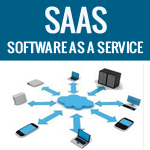Software is a driving force in business today. 
With more and more businesses going online,
investment in infrastructure and software is
something that every business needs to undertake.
Small businesses, at times are deterred by the high capital costs
need to cover software licenses and the hardware infrastructure
that go with it.
Software as a Service or SaaS
Software as a Service or SaaS is a new service model
whereby the small business pays a monthly subscription or fee to use software
that is accessible via the cloud, the software remains the property of the provider,
this removes the need for intensive capital investment on behalf of the small business,
This has obvious cost saving benefits which has special significance to business
epically in times of global recession.
The services that are offered under SaaS are –
- Applications – Software applications like ERP, database management systems, survey systems, email systems, and many more are provided by vendors on a usage basis to the subscribers. Service-oriented-architecture, web-services, enable the user to use and customize the front end based on their needs, so that the customers of the business do not realize that it is a cloud based environment or that the business is not the owner of the service. This ensures that the brand of the business is maintained and the user or consumer of the business does not feel alienated.
- Development Tools – There are many tools like azure, zoho, basecamp and many more that can be used by businesses. These tools can be used for business analysis, project management, wireframe creation, and at times even for development of other software. Similar tools when bought as standalones or for a business are very experience, and the per-license cost is very high. So, to share information, and use these tools across countries or at multiple locations, use of SaaS is an easier and more cost effective option.
SaaS has its set of advantages as well as disadvantages.
Advantages –
- Cost Effective – Businesses do not have to pay for the cost of licenses and infrastructure as the cost paid is based on the subscription that the company has chosen.
- Resource Effective – Other than the money saved, human resources are also saved as the effort and people required to maintain the infrastructure with latest updates, etc are managed by the vendor.
- Availability of latest updates – The service provider always ensures that latest patches and updates are always applied to the software. This ensures that the business gets to use the latest versions always.
Disadvantages –
- Security concerns – As data is stored over the web
on the vendor’s machines, security of data can be a concern for businesses.
Appropriate steps need to be taken to ensure that data is not compromised. - Lack of control – There may be times when updates may not be desirable, but the business may still have to compromise. If there is a downtime, it may not always be suitable to the business. In all these areas the business does not have a real control over the software.
As can be seen there are advantages as well as disadvantages
while using SaaS for small and medium sized businesses. It is for you
as a business owner or business managers to decide what suits the business best.
Thanks the TIB Team
